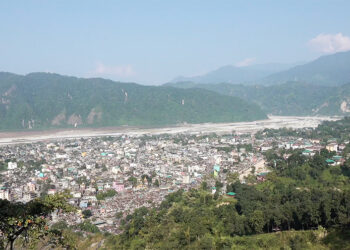
The pilot bus priority lane finally started last week more than six months after it was first announced. The priority bus lane allows buses, ambulances, vehicles with two or more passengers, and fire, police, emergency, and VVIP vehicles to ply on the left lane during peak hours. While some say the initiative is a commendable effort by the authorities concerned to ease traffic congestion, some are unsure whether Bhutan is ready for priority bus lanes yet.
 From 7 to 10 in the morning and 3:30 to 6:30 in the evening, the vehicles that are listed as eligible to use the priority lane category can drive on the left lane while private cars and taxis are required to drive on the right lane between Babesa zero and the Changzamtog flyover bridge.
From 7 to 10 in the morning and 3:30 to 6:30 in the evening, the vehicles that are listed as eligible to use the priority lane category can drive on the left lane while private cars and taxis are required to drive on the right lane between Babesa zero and the Changzamtog flyover bridge.
According to city bus drivers and their passengers, this initiative of designating lanes has reduced traffic congestion for them and consequently, made it easier to reach bus stops and their destinations on time.
“It has not only benefited me but also passengers who take the city bus. In the past, it used to take us around 25 to 30 minutes to arrive at Changzamtog and now we can reach here within 20 to 21 minutes,” said Phub Tshering, city bus driver.
“Personally, for me, it’s convenient to travel on the city bus now. It’s a public service, a very good idea, though it’s really hard to get a seat sometimes while travelling long distances like going to hospitals and towns,” said Ram Krishna Sharma, a city bus commuter.
“I take the taxi to the office and usually, there is traffic on both lanes but since the bus priority lane project started, the right side of the lane is much more congested compared to the bus lane. I think it discourages people from taking taxis or private cars, so it’s a good initiative to reduce carbon emission as well,” said Tashi Dawa, a Thimphu resident.
However, the initiative was not well received by everyone, especially taxi drivers. The taxi association says it will only increase traffic congestion for them and suggests that they, too, should be allowed to ply on the left lane.
“We appreciate and we always recommend their initiatives. However, we received several complaints from the taxi operators regarding the bus priority lane that started last week. So, the main thing is that taxi drivers are unhappy with the initiation of the priority bus lane because it affects their daily earnings. So, on top of that, there is a high risk of accidents. In addition, taxi drivers feel that the priority lane is not yet appropriate in Bhutan,” said Tshering Penjor, the executive director of the Bhutan Taxi Association.
“After the city bus service started the bus priority lane, we faced many problems. First of all, it has affected our business a lot. We request that they allow taxis to ply and stop on the bus lane. We would be very grateful if they could consider this. When we cannot ply the bus lane with one passenger, it affects us a lot. Sometimes, the lone passengers happen to be late for an appointment at the hospital or their work. That’s why, when we are not allowed to ply the bus lane, we lose passengers. If possible, we want the bus priority lane project to terminate or allow taxis to also ply on the bus lane,” said Thinley Dorji, taxi co-ordinator.
They added that the traffic will be more congested after the schools resume. Moreover, they cannot use the old Babesa highway as an alternate route during peak hours as most passengers usually wait on the expressway.
Likewise, some netizens also took to social media to express their views that it is too soon for Bhutan to start the priority Bus Lane. One person commented that the initiative is another failure in progress stating that this will cause a misery of traffic jams for other vehicles without additional lanes.
To this, the City Bus Service office said it will be too late if the initiative doesn’t kick off now. The Director of the City Bus Service added that a study by the International Finance Corporation, a member of the World Bank Group, indicated that it will take at least two hours to reach Babesa Zero from Chhubachhu by 2040 if they don’t act now. While there is no space to widen the road, he added, they will have to make do with whatever they have right now.
In addition, the Director added, the initiative will encourage car-pooling and the use of public transport thereby, reducing traffic congestion, and vehicular emissions and also supporting the economy by reducing the import of fuel and vehicle spare parts.
Thimphu Thromde in collaboration with City Bus Service, Thimphu Traffic Division (Royal Bhutan police), and Bhutan Construction and Transport Authority (BCTA) initiated the pilot Bus Priority Lane project.
Singye Dema
Edited by Phub Gyem






